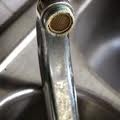 A leaking kitchen faucet presents a quandary of whether or not you should repair or replace the faucet. The answer depends on several things. Probably the biggest factor is the age of the faucet. If it is old you might lean more towards replacing it. Along with it being old, there are probably other parts in the faucet ready to break down, in addition to the styling of the faucet being outdated. So that all adds up to some serious consideration for replacement.
A leaking kitchen faucet presents a quandary of whether or not you should repair or replace the faucet. The answer depends on several things. Probably the biggest factor is the age of the faucet. If it is old you might lean more towards replacing it. Along with it being old, there are probably other parts in the faucet ready to break down, in addition to the styling of the faucet being outdated. So that all adds up to some serious consideration for replacement.
On the repair side of things, it may not cost you anything if you are somewhat handy. Several faucet manufacturers will warranty their faucets for life, but that doesn’t mean it will be easy, nor does it mean that you won’t be fixing something else on the faucet next month. However, a lifetime warranty is a lifetime warranty…actually I believe they phrase it as a limited lifetime warranty.
In some cases, they will replace the faucet (not including the labor to install it), but that is usually a chore to get done as well. The manufacturer may give it to you for free, or they may deeply discount the new faucet, or they may ask you to pay shipping and handling. Regardless, it is certainly worth a phone call to try to get a bargain.
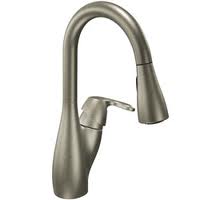 A kitchen faucet with a pull out spout is a wonderful feature. You don’t have the space taken up with a separate sprayer on the side, so these types of faucets can be mounted through a single hole which gives a very clean finish. The pull out spout is connected to a hose which is typically a beefy hose. It is braided or metal and is heavier than a vinyl hose. When you pull the spout out of the faucet, it should retract back into the faucet when you are done with it. Sometimes they don’t.
A kitchen faucet with a pull out spout is a wonderful feature. You don’t have the space taken up with a separate sprayer on the side, so these types of faucets can be mounted through a single hole which gives a very clean finish. The pull out spout is connected to a hose which is typically a beefy hose. It is braided or metal and is heavier than a vinyl hose. When you pull the spout out of the faucet, it should retract back into the faucet when you are done with it. Sometimes they don’t.
The hose attaches to both the spout and the body of the faucet, and its job is to simply transport water. The hose loops down into the sink cabinet and back up to the faucet body. There should be a small weight attached to the hose to help pull the hose back down once you release the spout.
Make sure that the hose isn’t tangled up in the drain piping…you don’t want it weaving in and out of the pipes obviously. Make sure the hose has a weight on the side of the loop that connects to the spout. If the weight is on the rear side of the loop, it will not help the hose retract. The weight is usually held on with a few screws that sandwich the hose in the middle.
 A kitchen faucet gets a lot of use and over time it may get difficult to swivel from side-to-side. This may also be accompanied by a leak at the base of the spout. You can remedy both of these problems at the same time.
A kitchen faucet gets a lot of use and over time it may get difficult to swivel from side-to-side. This may also be accompanied by a leak at the base of the spout. You can remedy both of these problems at the same time.
You will need to remove the handle from the faucet. It may be held in place with a setscrew or you may have to remove a cap on top of the faucet to access a small screw underneath it.
With the handle off, you can grab the spout with one hand on the spout and the other hand where it encircles the faucet body. Lift up as you move the spout slightly back-and-forth.
Clean up this area with paper towels and cleaner. Also clean the inside of the spout’s housing (the part that sits over the faucet body). You will also want to replace the o-rings at the top and bottom of the faucet body. You can pry them off with a sharp blade. You want to get new o-rings and plumbing grease.
Replace the o-rings carefully making sure they don’t twist as you install them. Use the plumbing grease to lubricate them as you install them. You can also use a thin film on the surrounding area.
Gently reinstall the spout and handle and the spout should freely swivel from side-to-side.
 So you are replacing your kitchen faucet, but you can’t get the old faucet off. What can you do?
So you are replacing your kitchen faucet, but you can’t get the old faucet off. What can you do?
If you have tried the normal tools…various wrenches and the like, it’s time to get serious. It is usually one of two issues: either you can’t reach the nuts well enough to exert force on them, or the nuts are stuck and they won’t budge.
If you can’t get access to the nuts, use a basin wrench. It is an “L” shaped wrench with jaws on the long side. The only issue is that it doesn’t allow you to get much leverage on the nut. You may be able to position the basin wrench with the handle facing the cabinet doors and then place a short length of iron pipe over the handle to get more leverage. It is awkward because you will have to keep the jaws engaged while moving the pipe with the other.
If you simply can’t get the nuts to budge, you can try a nut splitter or a power tool. A nut splitter is just what is sounds like…keep turning the handle until the nut splits. But, you may not be able to get the tool up there.
You can also try a dremel tool with a small cutting wheel on it. You probably won’t be able to cut through the entire nut, but maybe you can damage it enough where it will finally move. You can also use a reciprocating saw with a metal cutting blade. You have to be careful here and don’t let it shake and vibrate so much that it damages the surrounding area.
You really don’t care about damaging the faucet or nuts because you are replacing them anyway. Just don’t damage the sink or countertop.
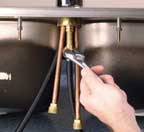 A kitchen faucet can get loose over time and require a quick fix. It seems that faucets with a single handle have more of an issue here than do faucets with separate hot and cold handles. I am guessing that because people push the lever to its extreme travel point and slam it back down causes it to move over time and eventually become loose. This also holds true for bathroom faucets
A kitchen faucet can get loose over time and require a quick fix. It seems that faucets with a single handle have more of an issue here than do faucets with separate hot and cold handles. I am guessing that because people push the lever to its extreme travel point and slam it back down causes it to move over time and eventually become loose. This also holds true for bathroom faucets
Fixing it isn’t difficult. You will need to climb under the sink to access the fasteners that hold the faucet to the underside of the sink (or counter). If you have a faucet that sits on a metal base, look for 2 nuts that hold the faucet on. The nuts may not look like nuts at all. They may be colored plastic, but they will thread onto a stud of some kind. On some faucets, you can follow the incoming water supply lines and the nuts will be on the same inlet that the lines are attached to. Other faucets will have separate threaded rods that allow nuts to be screwed on to them.
Faucets that have no base plate will have a fastener that looks like an open nut. It looks like the letter “C”. This allows the faucet to be tightened to the sink and still allow the water supply lines and sprayer hose to remain undisturbed.
Use a basin wrench to tighten the nuts that hold the faucet to the sink. This tool gets into tight spaces and allows you to tighten the nuts with little effort.
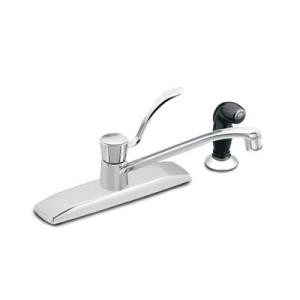 Have you ever used a kitchen faucet and when you turn the hot water on, cold water comes out instead? You usually find this after someone has just installed it or repaired the faucet. There a couple of situations that could have caused this.
Have you ever used a kitchen faucet and when you turn the hot water on, cold water comes out instead? You usually find this after someone has just installed it or repaired the faucet. There a couple of situations that could have caused this.
The first situation is where the installer actually crossed the water supply lines. You will see the hot water supply line connected to the cold side of the faucet and vice-versa. I can’t say this is very common because the hot water supply valve is under the hot side of the faucet. In other words, the left side of the faucet is the hot side, and the left angle valve is the hot valve.
What is more common is that the faucet is a single handle faucet and the cartridge’s stem just needs to be rotated 180-degrees. To access the stem, pop the cover off of the handle and remove the screw. This will allow you to remove the handle. The stem is what the screw was removed from. It is usually silver and sticks up noticeably. Hold the stem with two fingers and rotate it 180-degrees, then reinstall the faucet’s handle. That should solve your problem and make the right side cold and the left side hot.
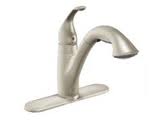 Kitchen faucet problems are inevitable. Sometimes the faucet body leaks, and sometimes the leak comes from the sprayer. For faucets with a pull-out spout, the fix might be very easy.
Kitchen faucet problems are inevitable. Sometimes the faucet body leaks, and sometimes the leak comes from the sprayer. For faucets with a pull-out spout, the fix might be very easy.
Faucets with pull-out spouts are generally higher quality and higher priced, but that doesn’t make them immune from leaks. The first thing to check is the connection where the spray head connects to the hose. This often becomes loose from people pulling on it and then twisting it to go from one sink basin to the other. You will see that there is a nut right below the spray head. Tighten this nut by hand…this may be all you need to do. Realize that you will probably have to do this every few months just because the act of pulling and twisting will gradually loosen this connection. There is a washer here that gets compressed to stop any leaks.
If the leak is not coming from this connection, carefully check the hose and the spray head. In a lot of cases, someone will pull out the spray head and let it go expecting it to self retract back into the faucet. Instead it falls and bangs into the sink. The spray heads can crack and leak, especially the less expensive models. You may need to order a replacement for this as most home centers don’t have a broad supply of them.
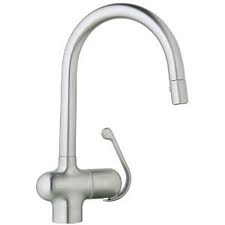 Kitchen faucets don’t often become loose, but certain faucets have a higher likelihood of becoming loose because of their design. Faucets with a pull out spout place more stress on the neck of the faucet because you have to grab the spout and pull it. If the faucet has a high looping neck from which the spout rests, when you pull the spout, it places stress on the top of the neck where it begins to arch up and around. This action pulls the faucet forward and can cause some movement over time on the fasteners underneath the sink.
Kitchen faucets don’t often become loose, but certain faucets have a higher likelihood of becoming loose because of their design. Faucets with a pull out spout place more stress on the neck of the faucet because you have to grab the spout and pull it. If the faucet has a high looping neck from which the spout rests, when you pull the spout, it places stress on the top of the neck where it begins to arch up and around. This action pulls the faucet forward and can cause some movement over time on the fasteners underneath the sink.
It is important to be aware of this as the faucet will get a little loose. There is also a small weight on the hose of the pull out spout that helps it to retract back into the faucet body when done using the spout. This also adds some pressure to the faucet when someone pulls out the spout.
So the answer is to make sure the faucet stays tight to the countertop or sink (whichever it is mounted to). If you crawl under the sink, you will see the underside of the faucet where it pokes through. Look for the water supply lines leading from the wall up to the faucet. There will be some type of screw-on nuts or fasteners that hold the faucet to the underside of the sink. Tighten these nuts. If there is only one mounting point, look for where the hose runs up through the faucet. Around this area will be a nut…only it doesn’t look like a typical nut. It will look more like the letter “C”. The opening allows the hoses to run through it. Tighten the fastener(s) and check it every now and then.
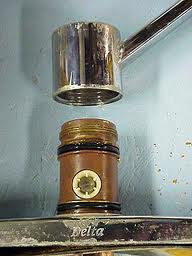 If your kitchen faucet leaks at the base of the spout when the water is turned on, you likely have some faulty o-rings. On a single-handle faucet, the handle will come off first. There is a screw under the cap which holds the handle to the faucet. Depending on the model, you will likely have to remove a cap nut before you can remove the spout.
If your kitchen faucet leaks at the base of the spout when the water is turned on, you likely have some faulty o-rings. On a single-handle faucet, the handle will come off first. There is a screw under the cap which holds the handle to the faucet. Depending on the model, you will likely have to remove a cap nut before you can remove the spout.
Hold the spout with one hand and grab the body with the other. Simultaneously pull up and rotate the spout’s body to lift it up and off of the faucet. You will see two o-rings, one smaller o-ring at the top of the body and another larger o-ring near the bottom.
Remove these o-rings from the grooves they sit it. They may be crusty and difficult to remove. You can try a sharp object like a knife to try to pry it out of the groove, but be careful and don’t scratch the faucet or it may leak permanently.
With the o-rings removed, install new ones in their places. Be careful not to twist them when installing them. You can use plumbing heat grease for this, but I like liquid dishwasher soap. The soap makes the o-rings slide right on. Reassemble the faucet and turn the water back on to test.
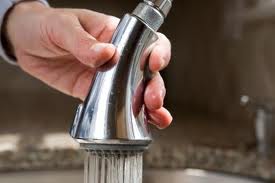 A kitchen faucet sprayer is a nice convenience, but it can lead to some small leaks after a while. There are different styles of sprayers, from side mounted to a pull-out spout, but they all have similar functions.
A kitchen faucet sprayer is a nice convenience, but it can lead to some small leaks after a while. There are different styles of sprayers, from side mounted to a pull-out spout, but they all have similar functions.
You may notice a water stain under the sink. This is something to check quickly. You may find a leak under the sink where the hose attaches to the handle, or it may be where the sprayer attaches to the hose. If you pull out the hose and turn the water on, you may find the leak where the sprayer connects to the hose. Simply try tightening the handle to the hose as this part tends to get twisted and becomes loose, which causes the leak. The water will run down the hose and fall onto the cabinet floor, which can cause damage. If the leak isn’t at the handle, go under the sink and check the connection there.
The fitting under the sink will either be a threaded connection or will use a mechanical clip feature. The connection under the faucet is more difficult, not only because it is under the sink, but because it usually isn’t a straightforward tightening job. You may end up adding some Teflon tape to the fitting, or you may and up buying a new sprayer hose assembly and installing it.